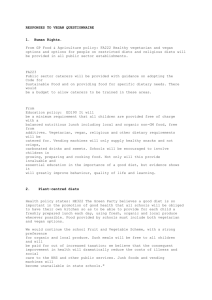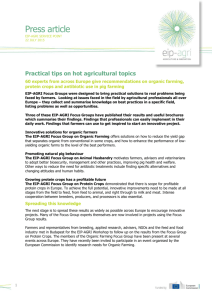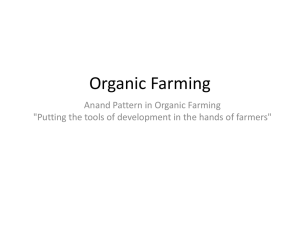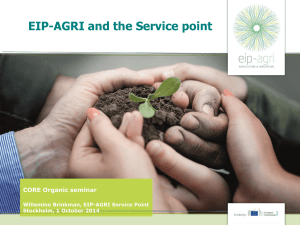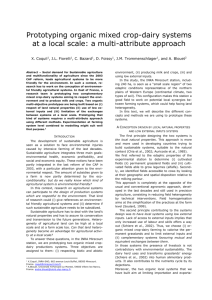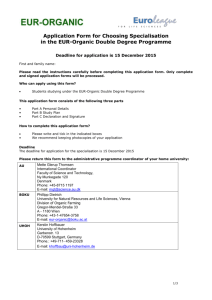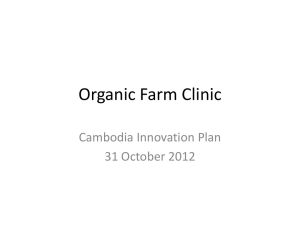The Organic Farming Movement in Cuba
advertisement
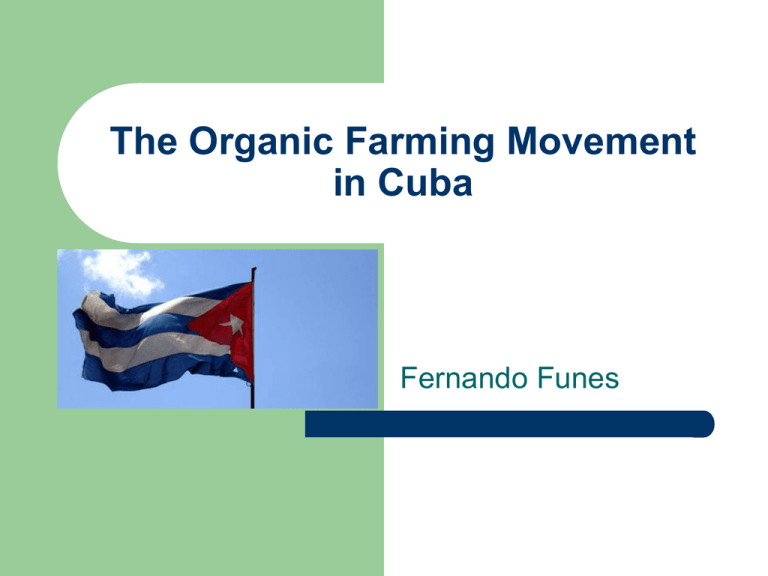
The Organic Farming Movement in Cuba Fernando Funes Pre-Revolution Land Distribution 9.4% of the land-holders owned 73.3% of the land 85% of the farmers rented their land More than 4 million hectares left uncultivated on large estates 200,000 landless families Over half of the best agricultural lands lay in the hands of foreign owners Agriculture During the Revolutionary Period Land was distributed to more than 200,000 peasant families 70 % of the latifundio lands were passed over to the state control Early days—emphasis in agricultural diversification (nature-friendly) …but period tendencies pushed toward conventional agriculture Objectives of Revolutionary Agriculture To meet the food requirements of the population To generate export earnings To provide raw materials for industry To eradicate poverty and unsanitary conditions of the countryside Conventional Agricultural Problems Over-specialization, monocropping, and excessive intensification Excessive dependence on external inputs Large-scale deforestation Salinization, erosion, compaction, and fertility loss of soils Unsustainable intensive factory farming systems of cattle, poultry, and pig production Heavy rural-urban migration “Special Period” in Cuba 1989—Acute crisis began suddenly with the collapse of the European socialist countries and the disintegration of the Soviet Union Prior to 1989—more than 85% of Cuban trade was with European socialist countries --Little more than 10% with capitalist countries Cuba imported two-thirds of its food stuffs, almost all of its fuel and 80% of its machinery and spare parts from socialist countries Effects of the Crisis Purchasing capacity was reduced to 40 percent Fuel importation reduced to a third Fertilizers reduced to 25 percent Pesticides to 40 percent Animal feed concentrates to 30 percent **All agriculture seriously affected Objective of Special Period Agr. Policy To shift to a low external input form of agriculture, while at the same time boosting production Pillars for Transformation Scientific & educational development Specialized institutions Specialized legislation Research Teaching Extension Productive practice Structural Reorganization Decentralization of the state farm sector through new organizational forms and production structures Land distribution to encourage production of different crops in various regions of the country Reduction of specialization in agricultural production Biological pest controls and biofertilizers Renewed use of animal traction gardening movements—urban,family, and community Farmers’ markets under “supply and demand” conditions Organic Farming 1970’s and 1980’s—Cuban scientists and farmers started searching for alternatives to high input agriculture Many traditional practices were remembered “agroecological Lighthouses”—farms where agroecological concepts are applied and which promote sustainable production systems in different regions *aimed at the production and marketing of organic products *Collaborates with other organizations to create education, research, and development programs on sustainable agriculture Why Cuba won the “Alternative Nobel Prize” Organic Fertilization and Soil Conservation (manure, sugarcane filter-cake mud…) Ecological Management of Pests, Diseases & weeds (Biological control by using predators, insect pathogens, and disease antagonists) Crop rotation and polyculture Legume-based livestock systems, silvo-pastoral systems, and integrated crop-livestock systems Why Cuba won the “Alternative Nobel Prize” •Ecological Soil Management •Successful Organic Farming Experience •Popularization of small rice production •Medicinal plants •Incipient organic development programs •Organic fruit production •Organic coffee and cocoa Methodology Universities Farmer to farmer The Ministry of Science, Technology, and Environment has given priority in recent years to research in sustainable agriculture Does not represent a change of technological models, but of the very way in which we conceive of agriculture Considers the farmer as a cultural and not just productive unit Organics as an Alternative “Its principles run counter to the vicious globalization promoted by neo-liberalism, and are more in favor of a socially just and solidarious, more human globalization, without dependency on transformation corporations and in favor of self-sufficiency.” Favorable Conditions Strong demand for agricultural products Plenty of qualified personnel linked to agricultural activities Population experienced in community work Administrative and social structures that support food selfsufficiency Official mass media willing to sponsor publicity campaigns for the peoples’ benefit Research results that are compatible with the new model The return of many people to the countryside in recent years Organizations dedicated to the creation of an agroecological culture


